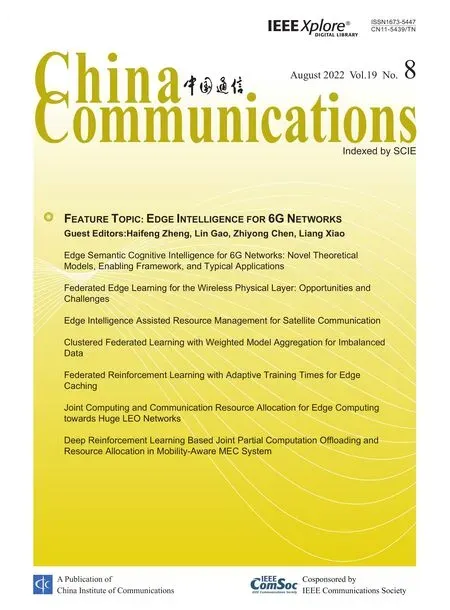Paving the Way for Economically Accepted and Technically Pronounced Smart Radio Environment
Mostafa Salah,Andreas Pitsillides,Ahmed S.Mubarak
1 Department of Electrical Engineering,Sohag University,Sohag,Egypt
2 Department of Computer Science,University of Cyprus,Nicosia,Cyprus
3 Visiting Professor,University of Johannesburg,Department of Electrical and Electronic Engineering Science,Johannesburg,South Africa
4 Department of Electrical Engineering,Aswan University,Aswan,Egypt
Abstract: Recently, Reconfigurable Intelligent Surfaces(RISs)have been introduced to provide the necessary flexibility for the design of the Smart Radio Environment (SRE), which can be optimally shaped to facilitate efficient signal transmissions. In line with the concept of smart cities, SRE needs to be carefully designed with respect to the city infrastructure and utilization of resources. In this paper, we provide our vision on RIS integration into future Smart Cities by highlighting the potential technical, environmental, and economic motivations of RIS deployment in harmony with various ecosystems at a city level such as buildings facades. To this end, we are pointing out some scenarios for mitigating the conflict between RIS realization and the existing building fac?ade’s ecosystems such as advertising display and solar cells on building walls. Also,in this fashion,the proposed vision supports a win-win relationship between all stakeholders of different ecosystems. This study presents guidelines for not only enabling seamless economically accepted RIS widespread utilization but, also more technically sounding SRE by supporting enhanced RIS features and more advanced applications that cannot be attained by traditional passive RIS.Moreover,based on the current research directions,we offer promising insights for cost-effective mass production through motivating two scenarios of “all on silicon” and “all as metasurface” fabrication technology. With this study, we aim to encourage the metasurface researchers, that for a broad deployment of the technical solution, economic, environmental, and other commercial requirements should be planned together,early on in the design phase.
Keywords: smart radio environment (SRE); reconfigurable intelligent surface (RIS); 6G; passive/active metasurface
I. INTRODUCTION
RECENTLY,intelligent metasurfaces have emerged as a hot research topic in the communication research community. It is predicted to lead to a breakthrough in conventional wireless communication,channel control, and trans-receiver structure [1–3]. It is commonly acknowledged as a core feature in the planning of sixth-generation (6G) and new wireless local area network (WLAN) technologies. For example the authors in[4,5]suggest that 6G will need to incorporate communications infrastructure into the environment’s very fabric. A Reconfigurable Intelligent Metasurface(RIS)1is composed of many reconfigurable metaatoms. The surface impedance can be programmed to adapt the incident electromagnetic (EM) wave propagation [6]. It can reshape the incident wave according to the required function, namely, focusing/steering the beam at any direction, transparent transmission, spreading, and transmission/ reflection with modulated amplitude,frequency,phase,and polarization[1–3]. This wave adaptation can be realized passively through dynamically programming the phase shift of the low-cost surface elements. Such adaptation may be performed by varying the biasing of some elements such as a varactor diode. However,for hardware limitations, phase shifting cannot be performed continuously to any value. Hence, employing some discrete levels of phase shifts can be optimized for reasonable beamforming gain [7–9]. Through the introduced EM wave adaptation,the un-controlled wireless channel is transformed into a controlled environment[2]. This transformation has many positive impacts on the communication link quality and spectral/energy efficiencies. In this paper, our focus regarding meta-surface applications is on the solution of communication problems. To illustrate the diverse applications, among the plethora of research works, we mention the following indicative works: embedding RIS in the environment to manipulate/control wave propagation[2,3,10];overcoming channel dispersion(multipath reflection and Doppler shift)[11,12];overthe-air channel equalization [13]; enhancing security[14, 15]; enhancing edge computing [16] ; optimal user-RIS association[17];enhancing the performance of non-orthogonal multiple access (NOMA) assisted networks[18,19];simultaneous RIS assisted wireless information power transfer (SWIPT) [20–22]. Furthermore, more advanced functionalities were introduced such as multi-RIS[23],RIS-based beam routing[2,24],and aerial RIS[25].It is interesting to note that aerial RIS was proposed to provide an additional degree of freedom in 3D beamforming[26]and enhancing cellular communication systems through performing reflections on the sky [27, 28]. As expected, the research focus has been directed towards solving the fundamental problems and proving the technology’s feasibility. However, several economic and technical issues still need to be addressed and overcome to pave the way for the broad deployment of this emerging technology. Despite the continually growing research efforts in exploiting metamaterials and metasurfaces,there is an unfilled gap regarding the financial and environmental perspectives. Specifically, to the best of our knowledge, there is no research study about the joint technical and economic motivations, which can initially empower and speed up realizing the intended radio-friendly environment. Moreover,there is no transparent business model built upon a win-win relationship among the different stakeholders,such as network operators, buildings’ owners, media companies, municipalities, and mobile users. For example,wireless network operators would struggle to provide sustained connectivity with minimum power consumption supported by RIS technology,mainly due to(building)site concerns akin to antennae tower placements. Beyond environmental concerns, it is anticipated that network operators cannot give the building’s owners a considerable commercial incentive, as compared to billboards investment and photovoltaic integrated buildings(PVIB).
In this paper, we consider an SRE using RIS for outdoor scenarios, as shown for example in figure 1 and discuss concerns about the widespread realization of SRE by revealing hidden technical, commercial,and environmental challenges that ought to be considered together. An integrated vision for enabling widespread SRE deployment is proposed based on jointly satisfying all“stakeholders”commercial interests. Instead of regarding other economic activities(e.g., an advertising side-road display), in isolation from the RIS functionality, it is helpful to consider them together in terms of financial and technical perspectives.Consequently,it is expected that taking economic consideration into account can empower SRE widespread realization effectively. The suggested vision is not only motivated by economic reasoning but also motivated by technical reasoning such as increasing RIS functionalities and simplifying channel monitoring operations. So, for effectively realizing fast and self-empowered SRE, some guidelines are proposed for jointly integrating/supporting all competing economic activities related to building facades such as advertising and solar cell-based energy harvesting.The proposed vision is reinforced by providing/discussing technical insights supporting its realisability.The premise is that for realizing the SRE,it is not sufficient to regard technical challenges only,but must also consider commercial as well as environmental challenges. The rest of the paper is organized as follows.Section II discusses the economic challenges facing SRE’s widespread realization and some technical limitations related to passive RIS that may degrade the overall performance of SRE.The proposed integrated vision for SRE widespread realization is introduced in Section III. Also, for low-cost mass production, the opportunity for unifying the fabrication process is included in Section III. Section IV provides the technical insights supporting the proposed vision along with a SWOT analysis. Section V outlines open questions and suggested research directions. Finally,section VI concludes the paper.

Figure 1. Smart radio environment featuring RISs.
II. CHALLENGES OF RIS WIDE SPREAD DEPLOYMENT
For realizing SRE in the outdoor environment,a wide deployment of RIS on a large number of buildings surfaces is needed. Changing buildings’ skin to become radio-friendly incurs critical questions about its compatibility from environmental, commercial, and technical sides. Commonly, the viability of the SRE is based on the known low cost of metasurface fabrication only. However, many other factors should be taken into account. While RISs coating walls and ceilings are seemingly simple in an indoor environment,it represents a real challenge in an outdoor environment where the economics and environmental aspects of deployment are much more challenging. For example, a prominent factor is expected to be the renting cost,which appears too exhaustive to today’s mobile operators sitting Antennae and BSs. Another aspect, prominent in today’s 5G deployment, concerns(mis)information regarding its environmental side effects, posed by certain so-called ‘marginalised, but vocal’ citizen groups2. Thus, the site and deployment economics and environment play a vital role in the competition for investment activities with a higher profitable return.
In this section, we discuss: 1) Environmental harmony of smart radio with the general concept of smart city/building concepts, 2) Economic perspectives related to the commercial exploitation of building facades, 3) Technical perspectives imposed by the RIS passivity constraint that limits its functionality from the technical side.
2.1 Environmental Issues
Despite the extensive research interest in the SRE/RIS,it is still not embedded in the everyday planning of smart cities, buildings, and facades. Very interesting review papers on the concept of smart city, building,and facade are touched on in[29,30].However,works in[29,30]have considered this concept from the communication point-of-view only.Specifically,they refer to the general outcomes of realizing RIS as enhancing coverage and connectivity whilst minimizing interference and EM radiation noise. Although improving communication services through smart radio facades may be regarded as one of the conditions imposed on the smart building,many other conditions should also be considered [31]. SRE must be introduced in the context of the overall smart environment, including green energy,sustained health and ventilation,thermal insulation, and controlled energy transfer. The conventional definition of smart facades [32, 33] can be stated as those that exploit the natural energy resources(solar,thermal,air,etc..) for meeting buildings’needs of energy(heating,cooling,and lighting). So,for empowering a smart environment, the concept of SRE should be handled as a subclass of the general concept of a smart city/building. The design of the green radio has to agree with all the requirements of green energy. Radio friendly environment already satisfies the environmental aims of reducing EM wave population by reconfigured radio wave propagation and reducing power budget at mobile scale and network scale.However,the RIS design should be embedded in the smart city without adversely impacting other environmental interests. For instance, if the design of RIS is nontransparent with a metallic rear, it will prevent solar energy harvesting besides limiting the visual view of the occupants.
2.2 Economical Issues
It is well-known that the impact of the economic perspective should be essentially emphasized before any claims about any engineering solution’s realisability. Unfortunately,despite the continually growing research efforts in exploiting metamaterials and metasurfaces,there is an unfilled gap in economic perspectives. One of these few studies appears in[34],which recommends incorporating the metamaterial in products and objects as an enforcer of a circular economy. Work in [34] aims to simplify monitoring and following the recycling of natural resources. Moreover, it suggests energy recycling by harvesting unwanted electromagnetic radiation, acoustic, heat, and vibrations into energy by tuning metamaterials’physical properties.
Many researchers in the communication community socialise SRE realisability in the future, premised on the negligible cost of the fabricating material of RIS metasurface. However, other hidden costs must also be considered, e.g. those residing in the building facades’renting cost,which needs to compete with other existing favorable commercial activities,as in figure 2.Usually, building facades are economically exploited through advertising displays or solar cell-based energy harvesting panels. The interesting question is whether these choices are more appealing to building owners in(already) having more gainful economic returns than employing RISs. At first sight,they seem to be,as the advertising budget usually is very high. So,the implementation of RIS may face strong economic competition which would be limiting its widespread realization. We discuss these commercial activities of building facades and billboards in more detail below:
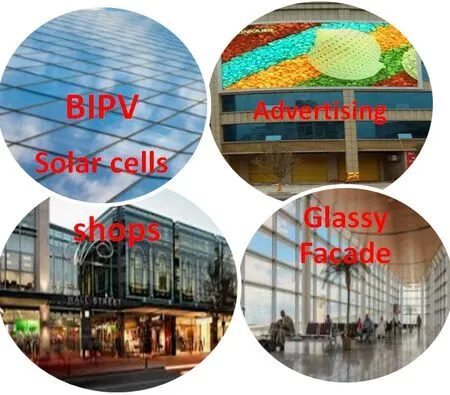
Figure 2. Competing economical activities of building facades.
? Media facades and billboards:There is an essential commercial activity for huge buildings in big cities through advertising displays on building facades[35–37]. Media facades are regarded as effective advertising tools. Huge light-emitting diodes(LED)screens may be incorporated on the building surface for displaying commercial ads.It satisfies the building owner by providing high rental income. These buildings usually are located in the centers of cities,where there are many shops, restaurants, and residential units. It represents a heavily populated area. From a communication point of view, the density of mobile users reaches a maximum in these areas. So,these urban spaces are continuously in urgent need of enhancing communication services, e.g.through SRE realization. Consequently, the situation looks like hard competition between mobile network operators and advertising companies. For example, advertising in Times Square(Manhattan, New York City, USA) may cost up to $3 million per month for the largest billboard[38, 39]. This for just for one billboard. So,what about renting a number of these billboards in that area? Advertising on electronic screens may be encountered in many different types, such as building facades or stand-alone billboards. However,all types usually enjoy common high visibility,as shown in figure 3.
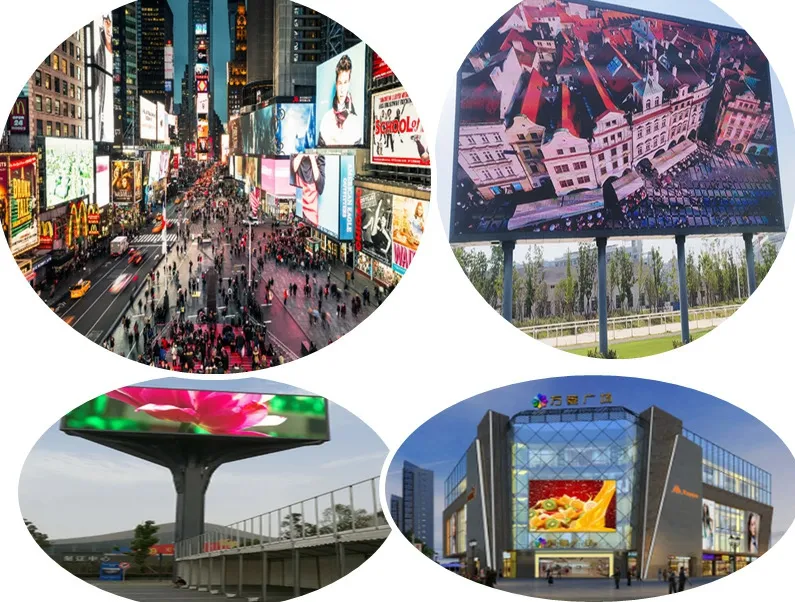
Figure 3. Examples of building facades and billboards.
? Solar cell-based energy harvesting on buildings walls:Solar energy harvesting represents another economic activity that exploits building facades and rooftops[40]. Building-integrated photovoltaic (BIVP) [41–46] is considered not only from financial concerns but also environmental concerns as well. Smart building can be designed for zero net power consumption. Work in[46]introduces recent advances in energy harvesting through the building envelope. Also, in[46] , many real examples of BIVP generating about 28-100 watt/m2 are highlighted. Furthermore,optically transparent solar cells are also recommended in [47, 48]. Moreover, thermal energy may be exploited besides solar energy as in[49, 50]. Accordingly, to complement or compete,RISs should be implemented and cover these buildings’facades without interfering with energy harvesting processes.
? Buildings with optically clear glazing:In some use cases, buildings and commercial activities mandate optically transparent glazing systems such as show boards, shops, malls, airports, restaurants. In such cases, optically nontransparent RIS will not be accepted as an envelope for facade and buildings skin. However, research activity in this direction is technically extremely challenging,and thus research at best is at its infancy. Noteworthy recent research work for controlling EM propagation while being optically transparent appears in [51–54]. So, in general,commercial/environmental limitations for providing RIS fabrication guidelines that best match the real world should be considered early in the design process.
? General remarks for economic aspects of RIS realisation:The commercial problem facing the widespread realization of RIS is outlined below:
– RIS technology has a positive impact on the network operators and mobile users; however, its economic return on the building’s owner is not clear.
– Many commercial activities already provide high outcomes for building owners.
– Mobile operators/RIS operators cannot afford commercial competition with media companies that are exploiting building facades.
This paper motivates the need for guidelines in embedding RIS in the outdoor environment and stresses that as the state of play is,the competition with other commercial activities is most probably unequaled. Thus,the technical realization of RIS should be driven by commercial realities for satisfying all competing stakeholders. This is elaborated further in the coming sections.
2.3 Technical Considerations
Technical considerations Other than the low cost of the metasurface, widespread RIS deployment is at times based on building passive RISs without an external power supply. However, passivity constraint leads to minimized RIS capabilities and functionalities, thus inhibiting more advanced scenarios and applications as discussed in this section. Even under a simple RIS reflection scenario [55], active RIS demonstrates enhanced signal-to-noise (SNR) level at different user locations compared to passive RIS.Whilst research on programmable metasurfaces is currently very active,as expected there are many open problems and controversies still to be resolved. Below we list a nonexhaustive list of considerations and concerns, which may affect their deployment.
? Energy supply: RIS technology is at times introduced as a passive surface,hence the deployment and operational costs are expected to be fairly low [56–58]. Passivity means that there is no external energizing source. This simplifies the task of realizing the SRE as it means just sticking RIS sheets on buildings’ walls and windows without incurring additional efforts to electrify.However,for reconfigurability,electronic components are normally employed. These components can be of very low power, e.g. in the VISOSURF project [59]. Nevertheless, some form of energy source,or even energy harvesting,is necessary. Thus, it relies either on a power source or on EM wave harvesting for providing the required energy for enabling its full functionality.For instance,the metasurface can absorb incident waves completely for self-generating power[60].In some cases,it is regarded as a passive reflect array[61,62].Active beamforming is often allowed in the base station(BS),while passive beamforming is preserved at the RIS side[63,64].Note that with passive metasurfaces the surface incorporates some dissipation of the incident wave while reflecting it [65] hence it becomes lossy. Hence,each RIS hop degrades the power of the routed wave.
? Processing offloading: For maintaining the simplicity of RIS hypersurface, it is normally equipped with limited processing capabilities.The needed computations and processing are offloaded on a specific RIS server at the network edge. So, the SRE, composed of many RISs,is controlled as an internet-of-thing (IoT) framework [2, 24]. However, the RIS functions are more complicated than just a wireless sensor. RIS needs sensing EM waves,tuning/updating its surface impedance according to the required function, reporting to the RIS server, and mapping server commands into proper tuning. All these complicated control and tuning functions[65]are offloaded to the RIS server. This offloading may impact on the desgin of the control plane and introduce additional latency, which can affect mobility and frequency range,as discussed below:
– Latency: Computation offloading on edge relaxes RIS processing capabilities by exchanging reports/commands to/from the RIS controller at the edge. For tracking Mobile Station with EM beam, the speed of exchanging control data has to be limited by extremely low latency. Total latency depends not just on the speed of the communication link between BS and the RIS;it adds reporting latency to the central server, RIS scheduling,server processing time,and routing delay before reconfiguring the RIS.Consequently,it leads to performance mismatching with high user mobility[66].
– Heavy Control plane: Usually, in wireless communication systems,the exchanged data is classified into control and user plane data.While user plane data is transferred at a higher rate than the control plane, control plane data is minimal and carried by a more trusted channel and broader coverage. The RIS that assists in transferring user data(user plane) affords heavy control overhead [57]for adapting/configuring RIS functions other than the conventional control plane needed for the MS. The RIS control traffic may be characterized as a burst transmission [67];however,its incurred latency imposes a high impact on beam steering and tracking [65–68] even in the indoor environment. Based on the RIS orientation and the mobility of the tracked object, there is a trade-off between the number of reconfiguration requests per second and steering accuracy.High updating frequency guarantees perfect tracking while leading to control network congestion.
– Lossy surface: Passive RIS incorporates some dissipation of the incident wave while reflecting it [69] related to its efficiency.Moreover,it absorbs some EM power intentionally for powering its circuits. So, each RIS hop degrades the power of the routed wave and imposes limitations on the number of hops.
– Addressing RIS limitations through Active RIS:Below we discuss many extended functionalities offered by adopting active Metasurfaces. In this case, it is expected that additional complexity and energy,hence manufacturing,deployment,and operational costs are the tradeoffs, which must be accounted for. Some examples are:
– Active channel estimation: embedding a few active sensors/antennas for sounding the channel state information (CSI) results in reduced complexity based on compressive sensing and deep learning[70–73].
– Latency minimization: Active metasurfaces can enable increasing computational and processing capabilities of RIS.Hence,it can perform the required processing internally.So, the need for edge computing can be relaxed,hence latency can be minimized[74].
– RF-chain free transmitters: An RIS combined with an RF oscillator can introduce RF-chain free transmitters, which may lead to the possibility of replacing small cells with many distributed smart surfaces [75,76].
– Positioning: Active metasurface-based positioning may be employed for refining the positioning[77–79].
– Wireless power transfer(WPT):Based on its widespread use,active metasurfaces are predicted to enable WPT everywhere[22,80].
– Supporting/Replacing Massive MIMO: Active metasurface can incorporate each part of the surface for receiving or transmitting signals[81].
– Zero loss /gain: Zero loss may be realized using an active metasurface. Moreover, active metasurfaces can introduce a power gain to the EM wave while reflecting it [82, 83].Hence,active RIS may replace the expensive deployment of RF amplifiers[84,85].
– Extending the frequency range:Active metasurfaces can introduce a broader frequency range than corresponding passive RIS [82,86,87].
Figure 4 describes From the above discussion providing the metasurface with a power source and enhanced computing (hence becoming a programmable active metasurface) enhances the operation of RISs and introduces more services, which cannot be attained through passive RISs as demonstrated in figure 4. To realise the powering of metasurfaces,an obvious option is to power RISs with solar cell-based energy harvesting. This will provide a straightforward solution for self-energizing the RIS.While this integration meets economic and environmental concerns,enhancing SRE performance by enabling hybrid/passive RISs raises additional technical challenges to be addressed.Several studies exploit the exposed surface of an antenna for harvesting energy while manipulating EM waves by implementing the antenna transparently on the solar cell[88–90]. For example,a study of a solar cell combined with a metasurface-based EM absorber appeared in[88]and with an omnidirectional metasurface antenna in [89]. Energy harvesting diversity is discussed further in section III.
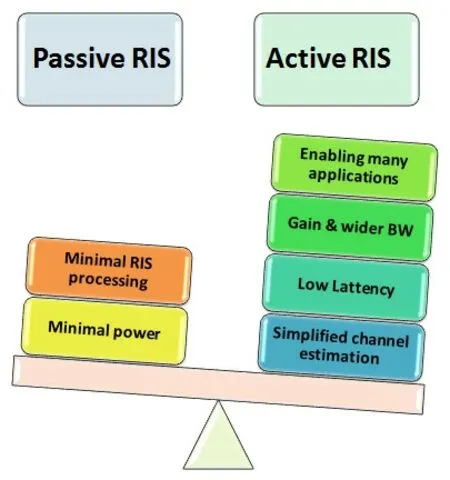
Figure 4. Passive versus active metasurface.
III. THE PROPOSED INTEGRATED VISION FOR SRE WIDESPREAD REALIZATION
Given the current state and trends,RIS operators cannot win the economic competition with advertising agents nor easily benefit from solar panels-based energy harvesting. In this section, an integrated vision of empowering SRE is introduced regarding economic and environmental perspectives while enhancing RIS functionalities beyond passive RIS.The introduced vision provides recommendations for encouraging research directions towards economically accepted and technically sound RISs. This is embedded below as a set of guidelines.
The proposed guidelines:
3.1 SRE Through the Global Vision of Smart City/Building and Governmental Regulations
SRE concept can be enforced better in the context of environmental planning,smart cities,and smart buildings. So,RIS should not be introduced only as a communication concern that increases mobile users’ data rates, but as an essential component in realising the smart city concept[30]. SRE supports many advanced scenarios and new services that could not be otherwise attained. Furthermore, as indicated in figure 5,environmental and commercial concerns should also be recognized early on for empowering SRE. So, introducing some governmental regulations will assist in setting up RISs into a new smart city.
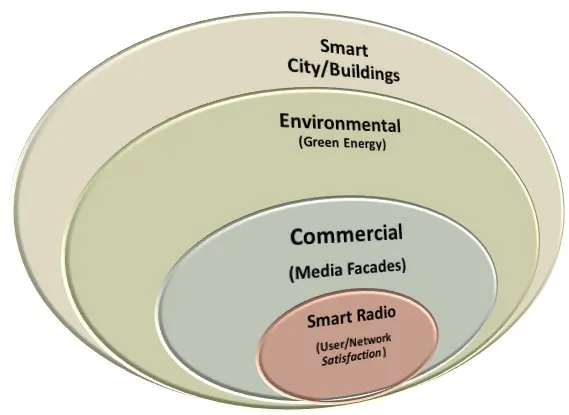
Figure 5.SRE embedded in the global city/building/facades intelligence.
3.2 Integrated Operator for Building Facade
When it comes to building facades, there are many stakeholders with different activities such as:
? Environmental regulations/compatibility (efficient heat exchange, green powering, occupant satisfaction, efficient ventilation, and visual comfort),
? Commercial interests(e.g.,advertising display)
? SRE realization through RIS coating of building facades. Some of these activities may interfere with each other. So, for efficient and noninterfering investment, specialist companies, as for example an integrated building facades operator(IBFO),can provide non-interfering applications of building facades.They can take care of all the technical challenges of integrating these activities into the buildings’facades. This provides one investment umbrella that would be interested in optimizing overall applications.
3.3 Win-Win Stakeholders Satisfaction
We believe that for effectively empowering the realization of outdoor RISs, it is necessary to verify in parallel the economic framework’s viability between the interested stakeholders instead of only regarding technical specifications,which if they are seen in isolation may seem commercially unattainable. For example, if we consider a building’s envelope/facade,with many different stakeholders competing for its utilizations,the optimal solution resides in exploring the opportunities of integrating all economic activities in such a way so as to convert the competing and conflicting game into a win-win game for all involved parties (e.g. the building’s owner, environmental regulations, advertising agent, RIS operator, etc...). figure 6. demonstrates the projected relationships between the involved stakeholders.
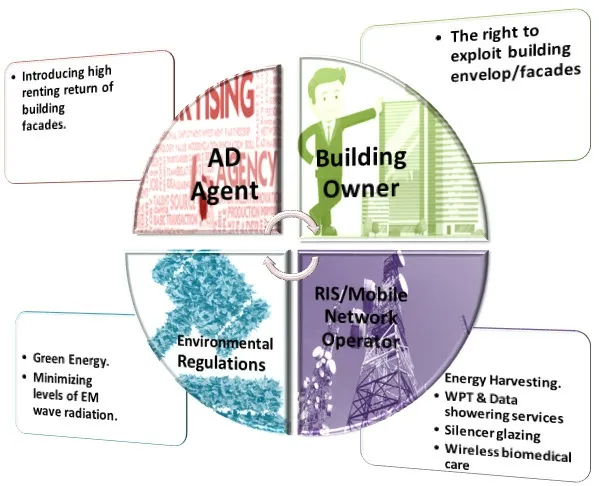
Figure 6. Win-win stakeholders satisfaction.
1) Building’s owner: Starting with the building’s owner,she/he has the right to exploit the building envelop in any way it is profitable for her/him. Naturally, the building owner is interested in maximizing real estate investment through the rental of the building’s facades, for whatever use, e.g. for advertising and solar energy harvesting, whilst respecting other concerns,such as environmental and legislative.
2) Environmental regulations: Minimizing net power consumption is one of the main requirements featuring smart buildings that obey environmental regulations. Zero net power building may be attained through integrating different renewable energy sources. Solar energy harvesting represents the most essential source where many solar panels can be fixed on building facades. Solar energy harvesting satisfies environmental regulations related to green energy while it increases owner income.
3) Advertising agents: They already provide high renting costs for exploiting facades. So, its role includes understandable direct benefits to the building owner.
4) RIS operator: The critical question arising here is about the RIS operator’s role and how relationships could be built for mutual benefits. Or, simply put,how can RIS operators persuade other players to accept them as partners? RIS operators most probably cannot incur high renting costs and pass these onto their clients, unlike advertising companies who can.This stems from the essential differences between the differing consumer’s nature in the two cases and commercial activities considerations. Traditionally, network operators rent a small number of building roofs for locating base stations with a reasonably high renting cost. However,it will probably become too costly to rent a large number of building facades,as may be required for effectively realizing smart EM wave propagation. For better wireless services/coverage,the design should be shifted not only from selecting optimum locations for citing BSs but should also include RISs installed in surrounding buildings.
It is worth noting that the exact commercial role of the RIS operator remains an open problem that needs more investigation, however, this paper introduces some of these ideas. Thus, the RIS operator may need to take part in the initial cost-sharing of the investment in facades,e.g.,glassy facades or unobtrusive solar energy harvesting.Or even,the RIS operator may offer free solar panels to the building owner with RIS surfaces embedded in them. Therefore,the building owner may see the benefit of allowing free RIS operation in return for solar energy. Moreover, RIS operators could introduce other essential services for the building’s owner such as:
? Metasurface-asssisted Wireless power Transfer(WPT)technology[22,80].
? Silencer glazing: where the acoustic energy harvester can attenuate outside acoustic noise[91].
? Data showering for the occupant and visitors.
? Supporting wireless biomedical care[92].
3.4 RIS Sharing Between Mobile Network Operators
For reducing the renting cost of buildings facades,RIS operators can share the RIS surface among many network operators, as shown in figure 7. The sharing mechanisms can be classified into:

Figure 7. RIS sharing mechanisms.
1. Time-division: where the RIS surface is allocated for each network operator for small-time intervals periodically. Centralized scheduling should be incorporated for ensuring fair and collision-free sharing.
2. Surface division: The large intelligent surface(LIS)can be divided into smaller surfaces that are independently deflecting the wave impinging on it. Some technical limitations on the beamwidths to be within the area of the small surfaces may need to be managed[24].
3. Spatial sharing: where the RIS can manipulate(e.g., steer) different EM beams received from different angles independently[93–95].
4. Spectral sharing: through multi-band multilayering RIS. The RIS exhibits different controlled behavior at each band[96,97].
3.5 Technically Non-Interfering Multifunctional Multi-Skin Facades: Optical Transparency
The main aim is to simplify RIS embedding in the real world by relaxing any conflict of interest with the general environmental regulations and commercial interests of the building’s owner, advertising agents, and occupant satisfaction. Hence, the suggested vision of multi-purpose RIS is based originally on integrating almost all possible economic activities in one consistent framework. Technical specifications of competing activities should be adapted for enabling all activities(media facades,solar energy harvesting,and EM wave manipulation through RIS covering)on the same surface.The multi-purpose functionality imposes constraints on the fabrication process of each purpose for enabling a non-interfering combination. Thus,there is a clear motivation for multidisciplinary researchers to optimize multifunctional surfaces based on these constraints that can be translated into technical guidelines for efficient fabrication.One highly recommended impactful research direction is the integration of optical transparency of the RIS and solar panel [54]. Further technical insights are introduced in section IV.As shown in figure 8, the same building fac?ade can have three layers stacked on the building as follow:
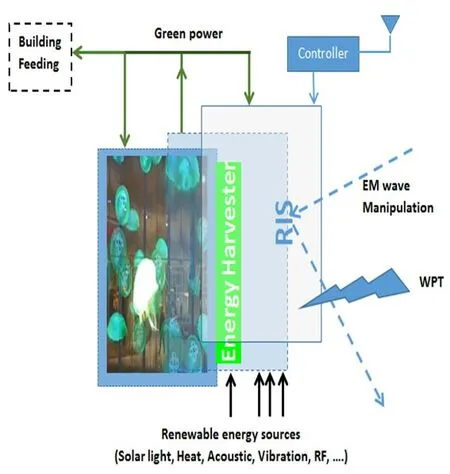
Figure 8. Suggested multi-layered/multi-functional fac?ade.
1. LED/Hologram display layer: for displaying the media ads. This satisfies the owner and Advertising agents.
2. Optically transparent Solar cell: for solar energy harvesting without interfering with displaying ads. This provides self-sustainability (selfpowering) for LED displaying, active RIS, and other building activities. Autonomous energy supply removes the passivity constraints on RIS.
3. Optically transparent RIS: for manipulating EM waves without interfering with light absorption in the solar cell.
Often, joint implementation of many non-related applications/purposes may degrade some application’s functionalities at the expense of others;however,some point of optimized performance can be attained.
3.6 Integrated Multifunction Smart Surface Meets Technical Perspectives: Active Metasurface Can Be Supported
functionality in terms of technical operation compared with the active type. Wireless power reflection and focusing[98]may be supported by passive RIS;however,with limited functionality.On the other hand,hybrid/active metasurfaces are provided with power,e.g with embedded energy harvesting,hence enabling the support of advanced RIS features and services. The supplied energy is not only exploited for enhancing internal RIS functionalities but also, simplifying other tasks, such as the provision of RIS-assisted SWIPT[20–22] and positioning [78]. Thus, integration of RIS with solar energy harvesting not only meets the economic motivations but also allows for technical enhancement gains.
3.7 Diversity in Energy Harvesting
Many sources of renewable energy can be provided with different power densities and continuity. For sustained energy supply,it is recommended to follow the generalized model for energy harvesting[99]that exploits multiple sources for energy harvesting. Indeed,many harvesters may be realized through metasurface structures,such as: -RF harvesting[100,101],which is already employed for providing the very low power required by semi-passive RIS.-Light-harvesting[102]that may replace solar panels under an all-on metasurface fabrication. - Acoustic harvesting/isolator[91, 103], which can provide silencer glazing also.- Vibration harvesting [104] that can provide a large amount of energy on a large scale[105]scenario(e.g.large surfaces coating walls,floor,windows,and ceiling).As indicated in[106],vibration energy has a high power density3(4μ-10m)W/cm2. Hence,any vibrations arising from outside (car movement) or inside(human movement) of the building [105] can be exploited for providing high harvested power.Moreover,meta-structures can be introduced for simultaneous vibration suppression and energy harvesting[107–110].It is worth noting that a new research direction aims to intelligently manipulate energy propagation through the recently emerged concept of“the Internet of Meta-Material Things(IMMT)”[111].
3.8 Unified Fabrication Technology: All on Silicon or All As Metasurface
The introduced economic vision for empowering SRE is based on the integration of RIS as part of the smart building that essentially supports solar energy harvesting and media display. So, the independently fabricated layers of RIS, solar panels, and the display may each be placed on the glassy surface of the media fac?ade. However, it can be expected that it will be more cost-effective if all layers can be jointly fabricated through a unified fabrication technology.
1. All on Silicon technology Already the solar cell and the display LED can be fabricated on silicon technology. Thus, if the metasurface RIS can be fabricated on silicon, this will stimulate the semiconductor lithography as a standard fabrication technology. Encouraging research exists on RIS metasurfaces build on silicon technology,(see discussion in technical insights).
2. All on Metasurface technology RIS is not the only layer that can be supported by a metasurface structure: Metasurface topologies can also support the energy harvester for harvesting light,heat, acoustic, or vibrations. Moreover, the metasurface-based hologram has emerged as the next generation of display technology [112]. So,one may unify the fabrication of the display,harvester, and RIS layers on metasurface structures by following the metasurface-based fabrication technology.
3.9 Supporting New Technologies of Media Facades
As shown in figure 9, media facades can be realized through a mesh of LED display. It is more interesting to have a flexible and transparent LED display.This enables simple installation through sticking on the glassy surface of the fac?ade. Recently, hologram display is introduced as the next generation of 3D display.
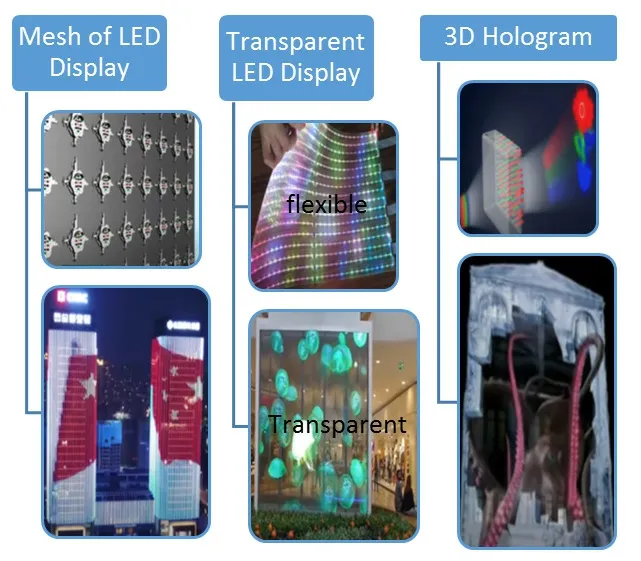
Figure 9. Technologies of Media Facades.
Figure 10 outlines the proposed guidelines for enabling widespread utilization of RISs.
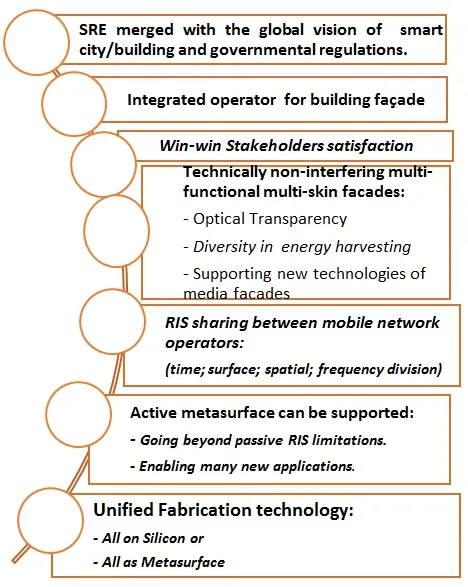
Figure 10. Proposed guidelines for empowering smart radio realization through the widespread realization of RISs.
IV. VISIONS FOR TECHNICAL REALIZABILITY
The claimed vision of an integrated RIS coated smart radio/building environment is supported by recent research directions concerning optical transparency and the all-on silicon/metasurface, which we outline below.
4.1 Optical Transparency
The non-interfering integration between different purposes related to the glassy fac?ade relies essentially on skin transparency. Many technical activities regarding the proposed multi-skin vision include:
? RIS transparency:recent research work addressed the possibility of fabricating microwave metasurfaces for controlling the EM propagation while being optically transparent [51–54], as shown in figure.11.b.
– The main common idea resides in employing an ultrathin film of an optically transparent and electrically conducting oxide such as indium-tin-oxide(ITO).
– Optical transparency enables the integration of solar panels behind the microwave metasurface. Moreover,another metasurface coating may be designed for efficiently collecting all radiation in the solar band with any incident angles and polarizations [113–115].
– Commercially, a prototype of an optically transparent window is manufactured by NTTDOCOMO from Japan [116], as shown in figure 11. It is based on the slight motion of the glass substrate with respect to the metasurface. Correspondingly, it can change its function from complete/partial reflecting and absorbing of the incident EM waves.

Figure 11. Examples of optically transparent LIS-practical realization.
? Solar cell transparency:There are many technologies for realizing transparent photovoltaic cells.Most of these technologies rely on employing optically transparent material with high electrical conductivity like the ITO mentioned above[47].
– It becomes common to practically integrate transparent solar cells in buildings for meeting building needs of energy [46, 117, 118]while ensuring occupant satisfaction.
– The choice between oblique and transparent solar cells depends on the need for clear vision for glassy windows[119]or media displaying[120].
? Media Facades transparency: The displaying facade may be designed with inherent transparency for occupant satisfaction[121,122].
4.2 Opportunities for Unified Fabrication Technology and Mass Production
For enabling low-cost mass production of the multipurpose building skin, it is worth exploring the available opportunities for unifying the fabrication processes for all applications intended on the building surfaces (RIS, energy harvesting, and AD display). We motivate two scenarios for the integration based on all semiconductor fabrication technology and all as metasurface technology.Our view is supported by referring to recent advances in the metasurface research track.Table 1 outlines that concept.
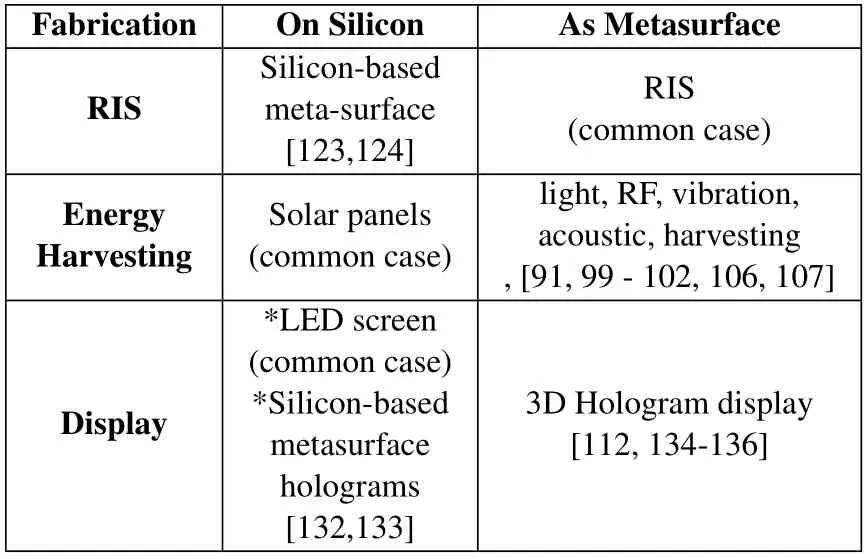
Table 1. Technical insights for all on siliconmetasurface.
1. All on semiconductor opportunities Already LED display and solar panels have been fabricated on Silicon according to the conventional semiconductor lithography. So, for validating the all-on silicon concept, it is needed to address the possibility of fabricating the EM metasurface RIS on Silicon. Given the current technology, it is expected to be easy for semiconductors to mimic the simple structure of metasurface composed of thin layers of metal on dielectric by varying its dopping. Semiconductors have emerged as a strong candidate for EM metasurface fabrication [123, 124]. Silicon metasurface opens the door for mass production of RISs through introducing compatibility with the semiconductor fabrication technology. Furthermore,the optically transparent indium-tin-oxide ( ITO)is just an n-type semiconductor film, as reported in [54]. The research in semiconductor metasurface track is essentially fuelled by optical applications [125–130]; however, it may be adapted for microwave bands. Moreover, the display can be realized by silicon-based metasurfaces. Light emitting-based-semiconductor metasurfaces outperform conventional LED display as in [131].Silicon-based metasurface holograms are introduced in[132,133].
2. All as metasurface opportunities The typical case is to provide RIS as a metasurface structure. So,the next concern is to indicate the possibility of providing the other functions of energy harvesting and displaying on a metasurface structure as follows:
? Metasurface-based energy harvesting As indicated above, many metasurface structures provide various types of energy like acoustic,kinetic,thermal,RF,and light-harvesting[91, 99, 100, 102, 107, 108]. This diversity ensures continual energy support throughout the day.
? Metasurface-based Hologram Hologram display can be supported by metasurface structures as in[112,134–136].It enjoys low fabrication cost,low noise,low absorption loss,high precision,high resolution,and ultrathin construction/ease of installation.
4.3 Techniques for Multifunctional Metasurfaces
The common concept of metasurface multifunctional EM wave manipulation includes anomalous reflection,full space manipulation(reflection/transmission)[137–140],absorption,beam steering,multi-band operation, and focusing. This follows the reconfiguration concept[141,142]. The intelligent surface can be reconfigured, or software programmed [1, 2, 6, 143]where the impedance of the surface can be tuned according to only one dedicated function. However, a multifunctional metasurface can jointly enable dissimilar functions, like jointly enabling anomalous reflection besides hologram display while providing selfpowering through energy harvesting.Therefore,under the all as metasurface structure, this integration can be implemented through the cascading metasurfaces,merging atoms of these metasurfaces, or designing asingle metasurface atom with different functions.
? Cascaded Multi-layered metasurfaces: Many independent metasurface layers are cascaded for combining their functionalities[139,144].
? Merged meta-atoms: The meta-atom structure is composed of merged different meta-atoms for jointly supporting two simultaneous functions[145].
? Single structure meta-atom: A carefully designed meta-atom is provided for jointly supporting two simultaneous functions[145].
Finally, in Table 2, we introduce a SWOT (strengths,weakness,opportunities,and threats)analysis for integrating RIS,Solar cell,and Display on Facades,from technical,economic,and environmental perspectives.
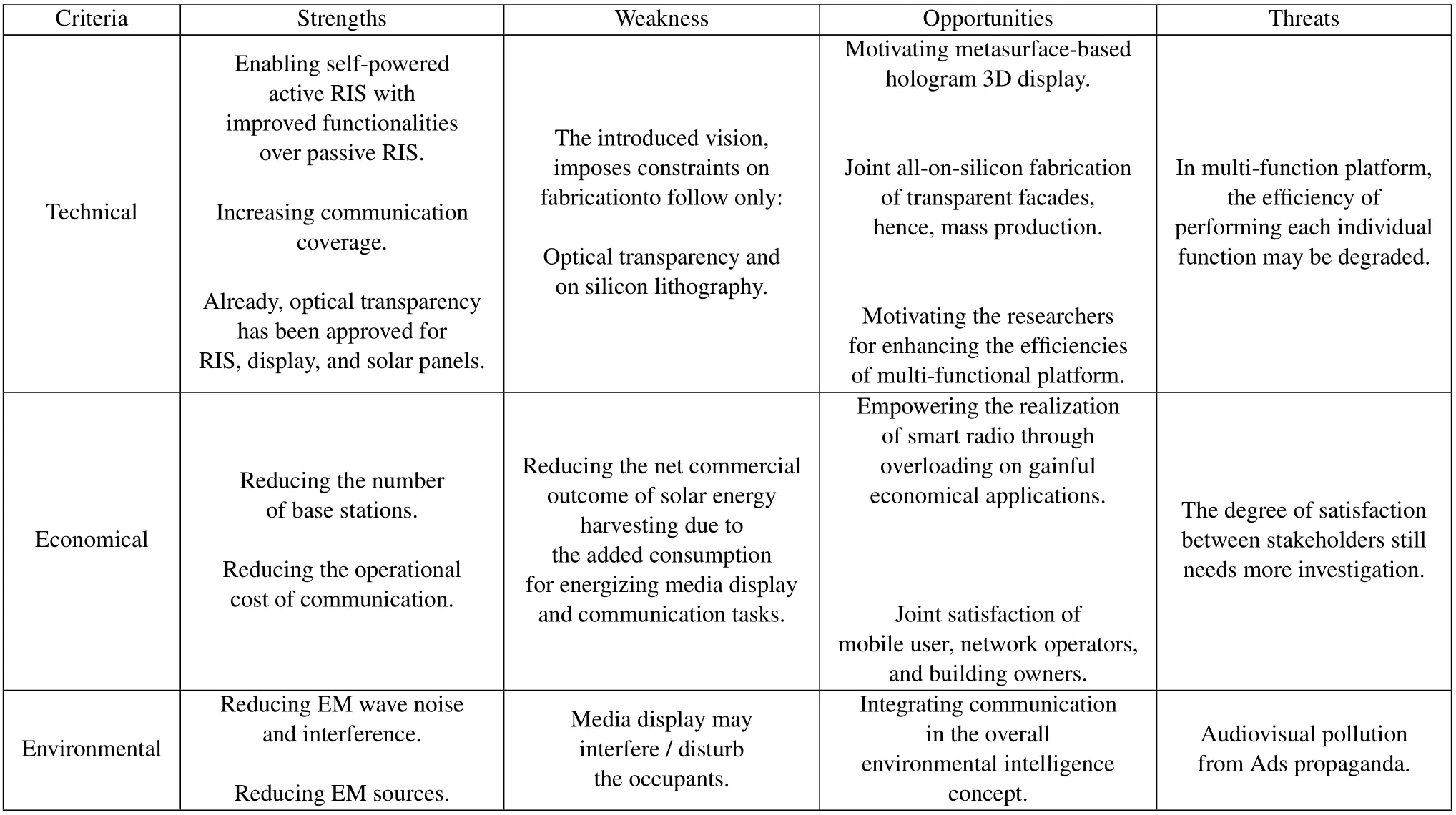
Table 2. SWOT analysis for integrating RIS solar cell and display on facades.
4.4 Joint Wireless Information and Power Transfer
Most research works focus on employing RIS technology as an essential enabler for enhancing the channel for wireless information transfer(WIT)and wave routing.On the other hand,there is less work on exploiting RIS technology for wireless energy transfer (WET)[98]in the context of a wireless powered communication network (WPCN). More interesting, a joint concern of simultaneous wireless information and power transfer (SWIPT) has been emerged recently [146–148]in spite of the differences in the design objectives.Hence,the same RIS surfaces may be exploited for simultaneously routing information signals and powering towards the intended users’ directions as well in indoor or outdoor environments.
V. OPEN QUESTIONS AND SUGGESTED RESEARCH DIRECTIONS
In this paper,we propose a multidisciplinary vision for jointly developing the RIS technology so as to capitalize on economic,environmental,and technical aspects together. Future directions for RIS and SRE research include:
? RIS and smart building/facades: a combined study of practical deployability of RIS in smart building/facades and its coexistence with other competitors to achieve non-interfering interests and optimize the overall performance.
? Optical transparency: realizing all fac?ade’s applications based on optical transparency while maintaining as high as possible efficiencies.
? Multi-functionality: achieving non-interfering multi-functionality with one simple and cheap fabrication technology and one surface for all applications. Also, to support reconfigurability and explore optimally cascaded units or carefully designing one unit with all functions enabled.
? All on Silicon: we encourage the investigation of semiconductor fabrication as a unified manufacturing technology for the multifunctional surface.Questions that need to be addressed include:
– Is it optimal for multi-functionality operation?
– Are there any enhanced approaches to be explored?
– Are there any better technological alternatives?
? Metasurface-based Hologram Display: exploring the effectiveness of replacing LED Ads display with hologram 3D display. Questions that need to be addressed include:
– Can it be merged with microwave metasurfaces as multi-band metasurfaces?
– Or,can we have one metasurface for all purposes (EM manipulation and hologram display and solar cell harvesting)?
? Hardware Implementation: for hardware realization, many technical challenges such as the integration of multifunctional metasurface and jointly tuning all functions should be addressed.
VI. CONCLUSION
Towards 6G and beyond, this paper poses challenges for the widespread realization of SRE based on RIS technology. The related technical, commercial, and environmental issues for paving the way for this realisation are explored.We postulate that the conventional claims(about low-cost metasurface and RIS passivity)are not sufficient by themselves for effectively empowering the widespread utilization of RISs,especially under competition from other commercial uses such as advertising display and solar-panel energy harvesting in coating building surfaces. For example,the passivity of RIS can impose severe constraints and overheads which may degrade the overall performance. Furthermore,an integrated vision that jointly meets technical,commercial,and environmental perspectives for effectively enabling the widespread deployment of smart surfaces is proposed. The proposed concept of multifunctional surfaces provides the main guidelines for empowering the widespread deployment of RISs without interfering with other building facades’ applications.We are motivating the establishment of economically accepted and technically pronounced SREs. Toward realising this vision, technical insights are provided for supporting integration,realisability of transparent RISs,advertising displays,and energy harvesting in unified all-on silicon or all-on meta-surface fabricating process. This gives rise to a win-win relationship between all stakeholders while increasing RIS functionalities with hybrid/active RIS support. The proposed vision is supported by referring to recent advances in the metasurface research track,such as optical transparency and silicon metasurface.With this paper,we aim to encourage the metasurface researchers,that for the technical path to be deployable,economical,environmental and other commercial requirements need to be addressed together, early on in the design phase.
NOTES
1Due to the rapid progress in this novel multidisciplinary topic,various acronyms and abbreviations appear in the literature,as for example RIS:Reconfigurable Intelligent Surfaces,IRS:Intelligent Reflecting Surface,LIS:Large Intelligent Surface,Hypersurfaces HSFs,and others.Throughout the paper we use the acronym RIS to represent all.
2In this discussion we do not consider any view regarding the environmental side effects concerns.
3Compared to(20μ-200 m)W/cm2 for solar energy harvesting(as a baseline).
- China Communications的其它文章
- Edge Intelligence for 6G Networks
- Register Allocation Compilation Technique for ASIP in 5G Micro Base Stations
- Deep Reinforcement Learning Based Joint Partial Computation Offloading and Resource Allocation in Mobility-Aware MEC System
- Joint Computing and Communication Resource Allocation for Edge Computing towards Huge LEO Networks
- Federated Reinforcement Learning with Adaptive Training Times for Edge Caching
- Arbitrary Scale Super Resolution Network for Satellite Imagery

